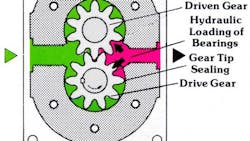Recently I was involved - in a supervisory capacity - in the planned change out of components on a hydraulic machine. The design of the machine's hydraulic power unit was the all-too-common, cheap and nasty, everything mounted on the tank lid variety. You know the ones - electric motor mounted vertically, with pump submerged in the tank. They're cheap and easy to build, but an eternal pain in the butt for anyone who has to work on them. I could rant about this... but I'll save it for another day.
The scope of work included changing out a tandem gear pump submerged in the tank. On this machine, a 15 minute job - AFTER you've spent two hours disconnecting everything to enable the tank lid to be lifted. I was offsite when this pump was changed, but the technician doing the work was experienced and knew what had to be done. After the shut down was completed, the same technician was scheduled to re-commission the machine. But due to conflicting commitments he became unavailable.
It was early in the afternoon when I got the call requesting I go to site to supervise start-up. Thinking this would be a case of push the button and watch everything behave as it should, I left the office in my 'civilian' clothes, took my personal car and no tools. BAD mistake.
Commissioning didn't begin well. The rear section of the tandem gear pump that had been replaced, charged an accumulator. But we weren't getting any charge pressure on start-up. The direction of rotation of the electric motor was correct. But what about the rotation of the new pump? Bit hard to tell when it's submerged in the tank.
After speaking with the technician on my cell phone, I was reasonably confident the new pump's rotation was correct. But just to be sure, I decided to try reversing the rotation of the electric motor (not ideal BTW). No change.
Now what? I don't have a flow-tester with me and it's a major job to lift the tank lid. It appears that new pump is either faulty or not priming. Unlike a vane pump which sometimes needs a head of oil on its outlet for the vanes to 'throw' and start pumping, a gear pump is typically self-priming - especially when it's completely submerged in hydraulic oil.
To give the new pump the best possible chance of priming, I topped off the oil level at maximum. Still no charge pressure after running for a minute. In the absence of a flow-meter, I decided to lift the electric motor off its bell housing, disconnect the pipes from the pump's outlet penetrations in the top of the tank and turn the pump by hand.
This was revealing. The front section was pumping, but the rear section wasn't. Joy. The rear section was faulty. I continued turning the pump by hand, while I wondered what the chances were of this happening, and contemplated the work involved in lifting the tank lid.
Just as I was about to give up and call for reinforcements, I noticed oil was being displaced from the rear pump's outlet penetration in the top of the tank. It WAS pumping. I reconnected the plumbing, dropped the electric motor back into position and bingo. We had accumulator charge.
It seems the pump's rear section was 'air-bound'. Had I been told this story about a gear pump that wouldn't prime itself when submerged in oil, I would have struggled to believe it. Of course, all possible precautions should be taken when restarting any pump. Failure to do otherwise can result in a costly premature failure. And to discover six other costly mistakes you want to be sure to avoid with your hydraulic equipment, get "Six Costly Mistakes Most Hydraulics Users Make... And How You Can Avoid Them!" available for FREE download here.
About the Author
Brendan Casey Blog
Author
Brendan Casey is a war-weary and battle-scarred veteran of the hydraulics industry. He's the author of The Hydraulic Troubleshooting Handbook, Insider Secrets to Hydraulics, Preventing Hydraulic Failures, The Definitive Guide to Hydraulic Troubleshooting, The Hydraulic Breakdown Prevention Blueprint and co-author of Hydraulics Made Easy and Advanced Hydraulic Control. And when he's not writing about hydraulics or teaching it, Brendan is flat-out helping consulting clients from a diverse range of industries solve their hydraulic problems. To contact him visit his company's Website:
www.HydraulicSupermarket.com

Leaders relevant to this article:
